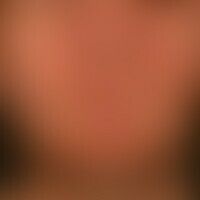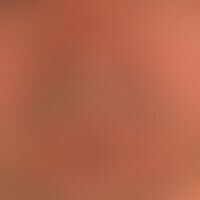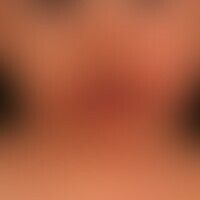Image diagnoses for "Nodules (<1cm)", "Face"
113 results with 250 images
Results forNodules (<1cm)Face
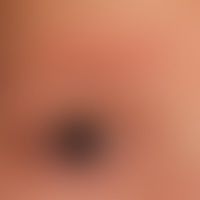
Ulerythema ophryogenes L66.4
Ulerythema ophryogenes: Extensive erythema in the area of the eyebrows in the case of incipient eyebrow rapairs; at higher magnification evidence of follicular papules.
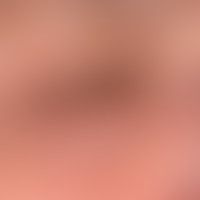
Fibroma molle (skin tags) D23.-
Fibroma molle: a harmless, symptomless "tumour" which has been known for many years and has remained unchanged without any symptoms; the presence of a completely fibromatically transformed dermal melanocytic nevus cannot be excluded.
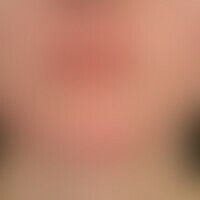
Acne (overview) L70.0
Acne papulopustulosa: multiple, inflammatory, follicular papules, papulo-pustules, inflammatory nodules and scars.

Demodex folliculitis B88.0
Demodex folliculitis: follicular inflammatory nodules. Infection of the eyelids.

Actinic elastosis L57.4
elastosis actinica. deep rhomboid wrinkles, with bulging skin relief, with pale yellowish skin discoloration. yellowish infiltrates can be detected when the skin is tightened. at the right edge of the picture brownish skin discoloration (lentigines seniles).

Seborrheic dermatitis of adults L21.9
Dermatitis, seborrhoeic: Multiple, chronically stationary, centrofacially localized (also on eyebrows and in the beard area), almost symmetrical, blurred, at times slightly itchy, red, rough, finely scaled spots and plaques on the face of a 32-year-old HIV-infected person.

Acne (overview) L70.0
Acne papulopustulosa: disseminated follicular papules, pustules and comedones; mild form of acne in an Ethiopian patient.

Cherry angioma D18.01
angioma, senile. 7 mm large lump on the cheek of a 70-year-old patient, existing for years, reddish-brown, very soft, almost completely compressible by finger pressure. skin clearly light-damaged; above left numerous linear telangiectasias. therapy not necessary; if necessary excision without safety distance.
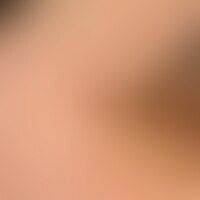
Facial granuloma L92.2
Granuloma eosinophilicum faciei: Very discreet, symptom-free, flat plaque that has existed at this site for 0.5 years. 42 years of otherwise healthy male.

Acne (overview) L70.0
Acne papulopustulosa: disseminated follicular inflammatory and non-inflammatory papules, pustules and retracted scars; recurrent course.
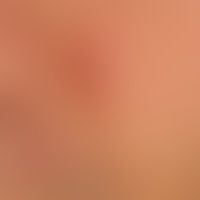
Lymphomatoids papulose C86.6
Lymphomatoid papulosis: Previous recurrent clinical picture in a 34-year-old female patient. Rapid, painless formation of a flat, surface-smooth papule, which developed within 3 weeks into a 2.0 cm large lump, which healed scarred within 3 months after extensive ulceration.

Leprosy lepromatosa A30.50
Leprosy lepromatosa: advanced findings with numerous, almost symmetrically distributed, asymptomatic papules and nodules, no accompanying inflammatory reaction.

Scar sarcoidosis D86.3
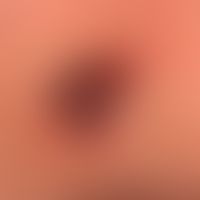
Basal cell carcinoma (overview) C44.-
Detailed view: The diagnosis "pigmented basal cell carcinoma" is visible at the left margin, where the spatter-like hyperpigmentation is found (accumulation of melanin clods in the tumor parenchyma, caused by the "accompanying proliferation" of melanocytes). At the upper pole local tumor decay and ulceration.

Angiosarcoma of the head and face skin C44.-

Tinea faciei B35.06
Tinea faciei. multiple, chronically active, since 4 weeks flatly growing, disseminated, 0.5-3.0 cm large, blurred, itchy, red, rough (scaling) papules and plaques as well as few yellowish crusts
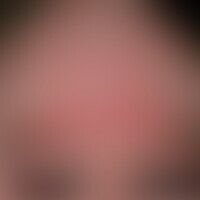
Rosacea L71.1; L71.8; L71.9;
Rosacea. stage II rosacea (rosacea papulopustulosa) Detail enlargement: Multiple, individually or grouped standing inflammatory papules, pustules and papulopustules as well as flat, red spots on the forehead and cheek area of a 62-year-old patient

Contagious mollusc B08.1
Small papular type of Mullusca contagiosa: focal sowing of small papular skin-coloured, smooth efflorescences reminiscent of verrucae planae juveniles; isomorphic irritant effect detectable.


